
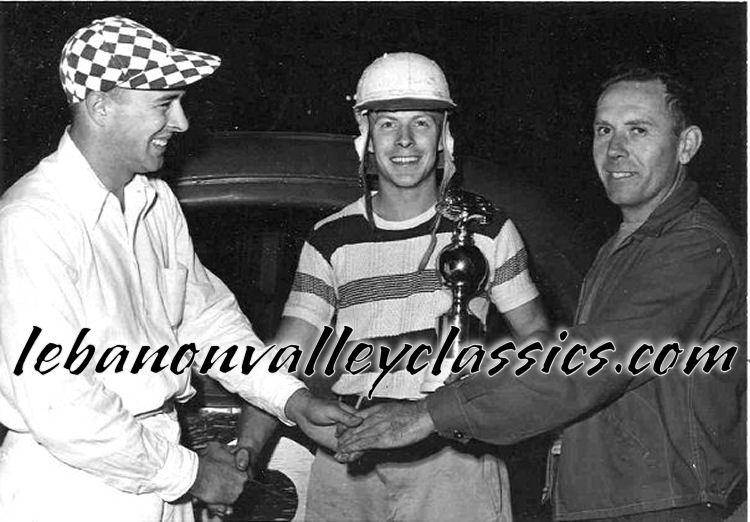
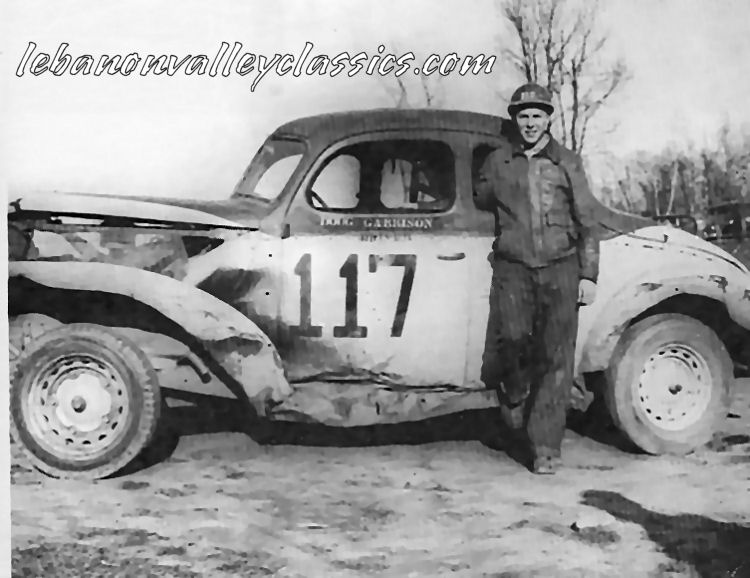
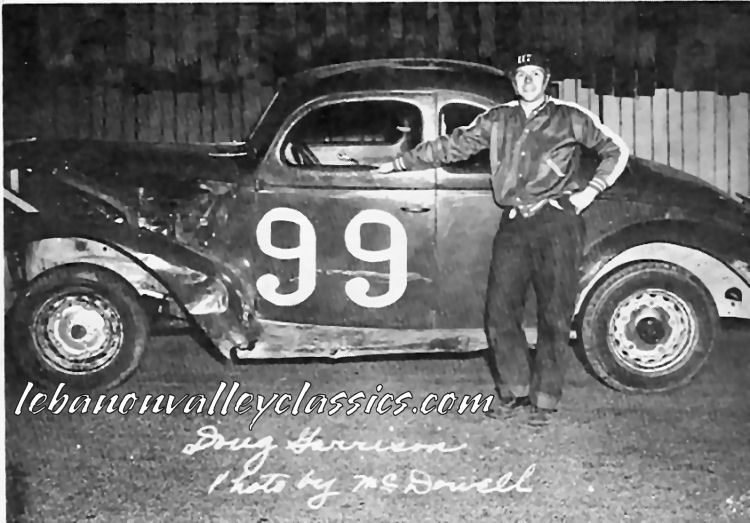
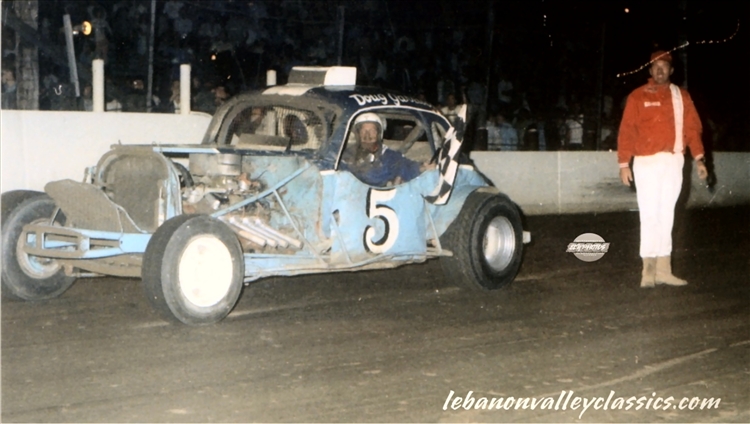
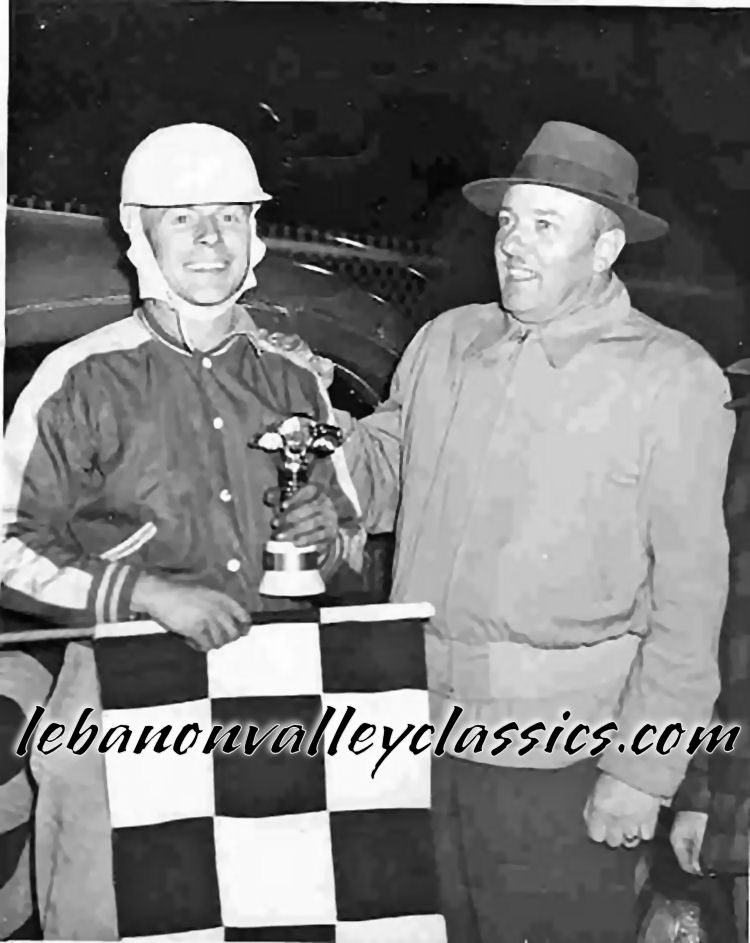
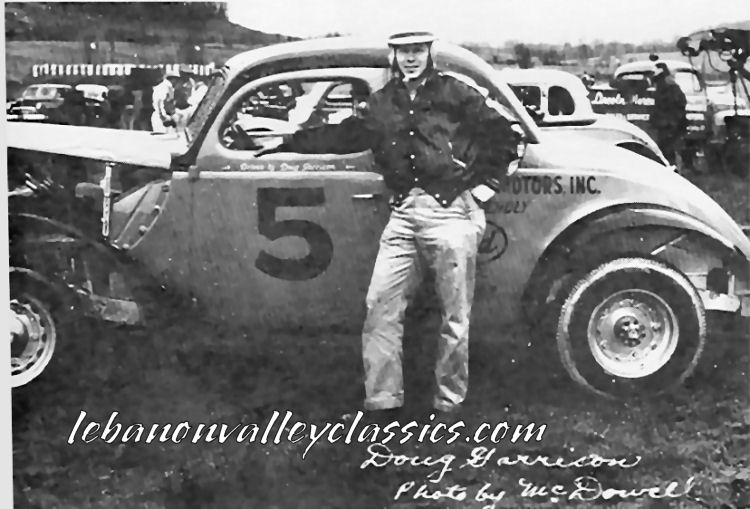

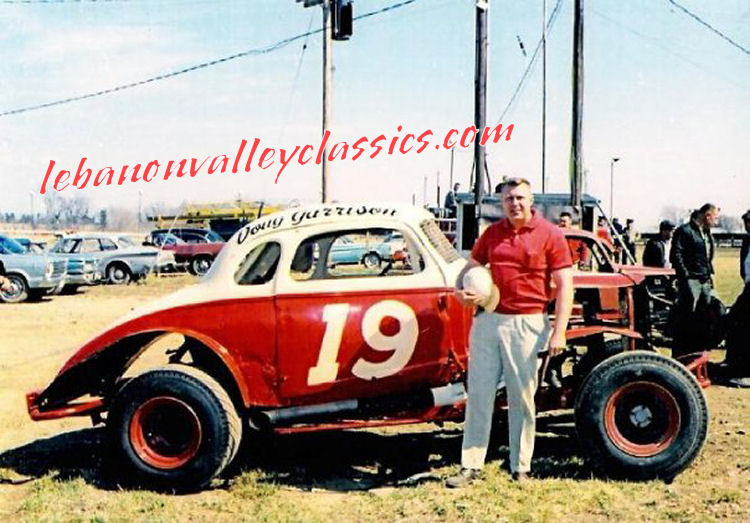
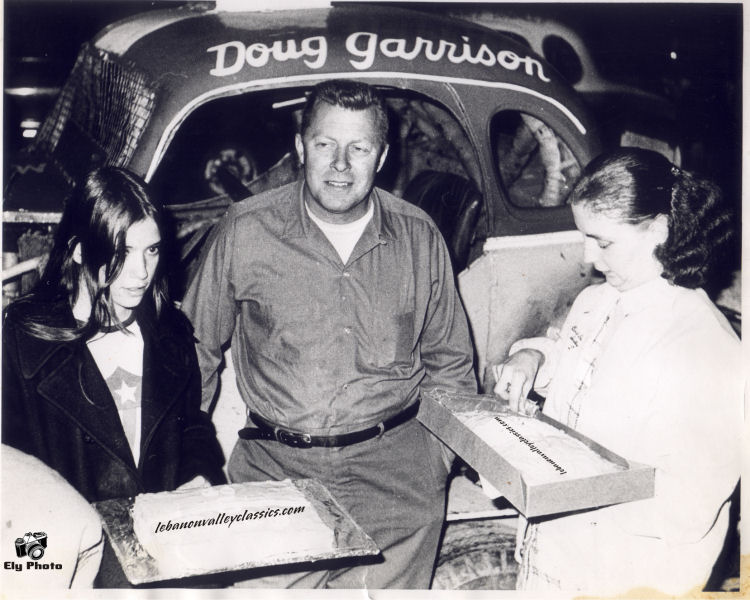
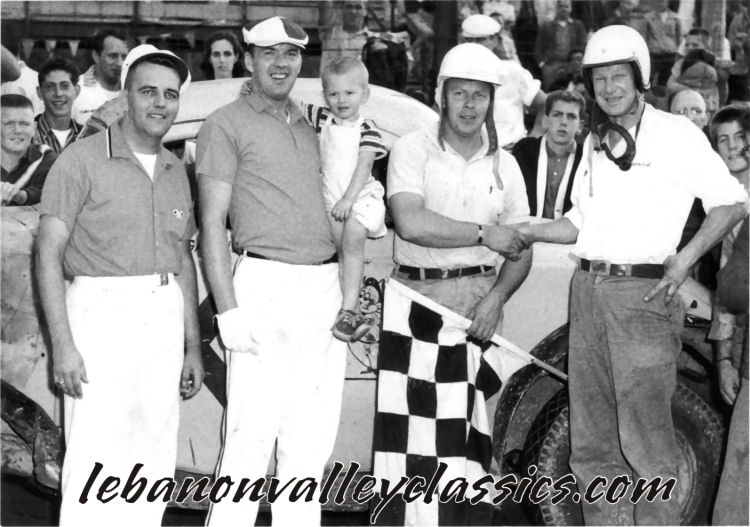
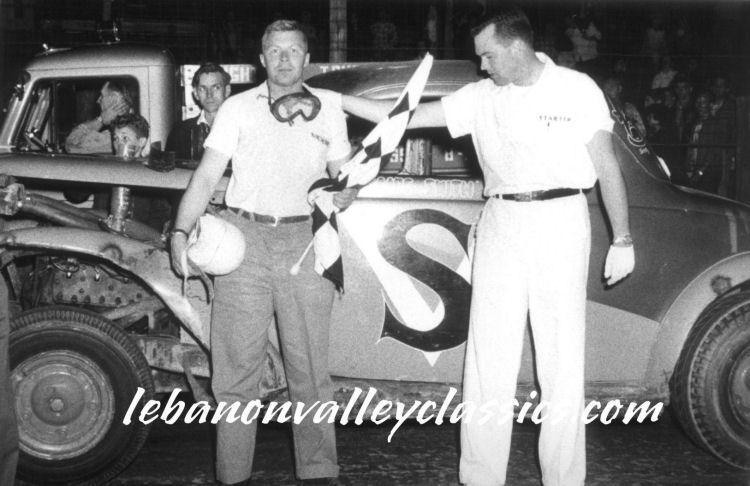
Top: Amy Garrison Dauski
Second: Amy Garrison Dauski
Third: Amy Garrison Dauski
Fourth: Amy Garrison Dauski
Fifth: Big Pete
Sixth: Amy Garrison Dauski
Seventh: Amy Garrison Dauski
Eighth: Ron Carr
Ninth: Amy Garrison Dauski
Tenth: Bobby Ely
Eleventh Photo: John Harper
Twelfth Photo: Bud Verge
Top: Unknown
Second: Unknown
Third: Unknown
Fourth: McDowell
Fifth: Chuck Ely
Sixth: Unknown
Seventh: McDowell
Eighth: Vera Carr
Ninth: Unknown
Tenth: Ely Photos
Eleventh Photo: Unknown
Twelfth Photo: Ray Williams
1971 Lebanon Valley Program:
Leroy Douglas
Garrison--a name that will echo off the banks of Lebanon Valley for many
years to come. Doug Garrison is to Lebanon Valley as Willie Mays is to
the Giants.
Having started racing in 1948 for Mannie Tompkins at the Burden Lake and
South Westerlo’s Speedways Doug’s career has been one that anyone would
be proud of. The first decade of Doug’s career shows high point
championships from many tracks.
The first of these coming in 1950 at Greenport Speedways. Barney
Thompkins owned the #99 that Doug campaigned in during 1950 and 1951 at
Arlington, Menands, Rhinebeck and Green- port Speedways. In 1952 Doug
had his own car and continued to set the pace. Coxsackie and Menands
Speedways were only a few of the tracks Doug was to collect
championships from in ‘52. 1953 found Doug “King of the Road” at Pine
Bowl where he raced his own #5. 1954 was a year that should be
remembered by many as Doug obtained a triple crown of championships;
Coxsackie, Menands and Rhinebeck.
From 1956 to 1958 Doug drove for Clyde Smith in the V-S. It was during
this time that Doug made the switch from blacktop to dirt racing. He
proved he was just as good on dirt by winning 8 straight features. At
the end of 1958 Doug started driving for Martin Riiska in the Yellow X.
This was a combination that was soon to prove very profitable for all
concerned. The one high point Doug remembers most from his first decade
of racing is in 1951 when he won a 250 lap feature at Rhinebeck and
picked up a fat check of $1,183.00. This is a large amount of money in
1951 but for a stock car race, this was a fantastic amount.
After Doug started driving the Yellow X most of his racing was done at
Lebanon. 1959 found Doug 5th in points and 1960 he was 4th. The late D.D.
Harris was first in 1961 while Doug came in second. 1962 found Doug
finish behind Johnny Flach and Link Pettit. Doug won the annual race for
the suds in 1961, 1962, and 1966. In 1963 there seemed to be very little
that Doug could do wrong. By winning the spring championship, the
Mid-season championship, Langhorne Qualifier and the Silver Dollar night
it helped to put Doug on top in points. This is one of the many honors
that Doug is quite proud of. It was at Langhorne in 1963 that Doug
finished 6th. This is the best a Valley driver has ever done. Doug was
also our qualifier in 1962 along with winning Silver Dollar night. This
race has been discontinued as silver dollars are no longer available in
large quantities. Lady Luck started to plague Doug in 1964 as he had
only one feature win, it was shortly after this that Doug started
driving for Gordon Ross in his famous red and white #19. The October
open in ‘64 found Doug finishing a respectable 3rd. No matter how hard
Doug tried 1965 was doomed to be a bad year. The only trophy Doug was to
receive was the hard Luck of the Year. Very few people enjoy excepting
this trophy.
August of 1 966 found Doug in the winners circle for his first open
competition race. He also managed to win three Saturday night features
to help him to finish 6th in points.
Although Doug managed to win the season championship, Langhorne
qualifier and the Ed “Doc” Carey Memorial the best he was able to do
again was 6th in points in 1967.
The open competition in September of 1968 found Doug finishing 3rd
behind Don Diffendorf and the late Jackie Evens. Again finding himself
within the top 10 in points; Doug finished 7th.
1969 just wasn’t Doug’s year. The best he was able to do was by winning
the September open to qualify himself for the 200. This was only another
way for Doug to establish himself with all the outside competition.
High hopes were had by all on Opening night in 1970. Doug won the race
and set a blistering pace and all his fans thought he would be the man
to recon with. Week after week it seemed as if “Lady Luck” completely
turned her hack on Doug. He finished out the season very depressed and
dejected. The annual point banquet found Doug among the missing as he
felt he had nothing to celebrate.
Through the winter a lot of hours were put in working to revamp the #5.
Preparing the engine became the job of Don Smith. Don has built many
engines for championship cars; the most recent of these was the #99 for
Stretch VanSteenburg. Along with Bob Bartholomew arid Doug’s son Doug
Jr., the car seemed to be shaping up. Opening night in 1971 found Doug
repeating what he had done a year earlier. Everyone was hoping the rest
of the season wouldn’t be the same.
Top Photo: Was taken at the Menands Speedway October 11. 1951 after winning a 50 lap championship race. Uncle Art, who afterward became Lebanon Valley's chief announcer, dons a real classic cap during the interview and photo.
Second Photo: Uncle Art, Doug and I believe Barnie Thompkins who owned the legendary #99 that was a top runner with drivers other than Doug. Stretch VanSteenburg was also very successful with Barnie's rides.
Third Photo: Doug poses next to the 117 ride I believe owned by Mannie Tompkins.
Fourth Photo: Is another shot of Doug and the #99 owned and maintained by Barney Thompkins.
Fifth Photo: A photo Chuck Ely took after another win for Doug Garrison. Must have been a hot night, looks like Doug has an air conditioning unit installed on the roof of the 5. It was actually a mirror. Legal then. With Doug on the track is Teddy Ryan, the Valley's chief started wearing a pair of his trademark high boots, (I remember black leather not hush puppies).
Sixth Photo: Another win for Doug in the Barnie Thompkins owned #99. I'm not sure who that is with him. Anyone have any idea?
Seventh Photo: Another Shot with his #5.
Eighth Photo: Doug with the Martin Riiska owned Yellow X (The Lil' Stinker).
Ninth Photo: A great shot of Doug and the Gordon Ross owned, red and white #19.
Tenth Photo: Not sure what the occasion was, but Doug receives a couple of LVC
sheet cakes commemorating some special event in his life. That’s one lucky guy.
Another Article featuring Doug Garrison. There were plenty written. In 1948, an eighteen year old left home to help "tweak" a buddy's race car at Altamont Speedway. When the driver didn't show, this boy was placed behind the wheel to pilot the car himself. A fine fifth place finish that day in a starting field of twenty racers sealed his future. Doug Garrison would be a race car driver. A mechanic at a local Chevrolet dealership and the physique of a star high school athlete, both attributed to his success. But it was his calm cool nature that took him to victory lane on more then one occasion. In 1950, he took over the seat of the Barney Thompkins owned number 99. This car took him to the track titles at both Rhinebeck and Empire speedways in 1951. Thompkins and Garrison liked to brag about the number 99. They had purchased it from Gordon Ross for just $800. The same day they took the car to Rhinebeck and won a cool $1,183, a profit of $300 in just one day. In 1952, Garrison took to the road, racing some eight times a week, and holding down his own job. He would run every night and twice on Sunday. These ventures would net him some three to four wins every week, on either asphalt or dirt. In 1956, he turned his attention to dirt track racing at Lebanon Valley and Onteora speedways. His traveling was decreased greatly, mainly held to the "capital district" tracks. In 1958, he was given the opportunity to pilot the Martin Riiska yellow number X. He took the car from last in the consolation to victory, tearing apart two gas tanks in the process. A few quick repairs and the X started from the rear again, claimed the victory in the feature. A partnership had emerged. The X was a tes. monster, perfect for Garrison's style of driving. They became almost an unbeatable combination. This teaming started Garrison on the way to 30 Lebanon Valley victories, including the 1963 Lebanon Valley sportsman championship. He was now almost totally dedicated to the Valley as his one' and-only speedway. This dedication led to him being called "Mr. Lebanon Valley". In 1964, Garrison moved on to the Gordon Ross team and car number 19. During this time he became friends with Valley Open winner, Frankie Schneider. Garrison respected Schneider for his ability to competitively race on a limited budget. Schneider even invited Garrison to run one of his number 2 cars at Nazareth's Mile and an eighth track. At that event Schneider elected to use used tires on both cars to save expenses. Schneider dropped from the lead with a flat tire, leaving Garrison with the lead. A few laps later Garrison also had to turn pit side with a flat right rear tire. Garrison purchased the Ross number 19, after numerous years of success as a team. Garrison was about to go it on his own in the now renumbered number 5. He won the opener at the Valley each ofth next two seasons with that car. He even took the victory in one of the Valley Opens, beating out Bill Wilson. In 1972, Garrison began to sense the changes about to take place in stock car racing. Just four years earlier the Valley had turned to big block modified power. Now the homemade tube chassis era was about to replace the faithful American made stock chassis. Garrison was asked to drive the powder blue coupe number 37, owned by Bob Helwig. Garrison took the ride with mixed success the next few years. In 1974, Helwig updated his ride to a four Koni Schwinning chassis. Still Garrison could not get the Helwig car to victory lane. A late season 1978 crash at the Valley 200 brought Garrison to realize the chemistry was gone. He would drive a few times for Helwig in 1979, finally to relinquish his seat to Dave Leckonby. He would still attend the races at Lebanon Valley in his retirement. He saw the changes he sensed to modified racing take place, and spoke about his concerns over the high speeds and inexperienced drivers. On April 12, 1985, the town of Green port declared the day Doug Garrison Day. Garrison was battling a long illness with cancer. Yet he spoke fondly of his racing friends and fellow competitors. On July 24, 1985, at age 55, he past away from his illness, leaving behind his family and wife Beverly.
Eleventh Photo: (From Left to Right) Head Starter, Dick Young, Ted Ryan (holding son Patrick) ,Doug Garrison and Howie Westervelt.
Twelfth Photo: After the resident LVC expert identified the driver of the VS, or SV, it turned into a no brainer once I heard. The man in victory lane is none other than Doug Garrison (Hey, I still had 11 years to go before I was even born). The car was owned by Clyde Smith, who in his own right, was an excellent chauffeur from what I hear, but He decided to let Ole Douggie run the car for him. I assume that is Teddy Ryan in victory lane with him.
Additional Comments: